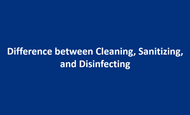Know the Real Difference between Cleaning, Sanitizing, and Disinfecting
Posted by David Cannon on 11th Aug 2021

The COVID-19 pandemic has been a global concern since early 2020. Prominent medical and health organizations like World Health Organization (WHO) advised preventative measures to protect people from the gravity of the infection and reduce the transmission rate. With hashtag social distancing and stay home becoming the new normal and as part of the WHO guidelines, several people have increased cleaning, sanitizing, and disinfecting in their daily routine be it in homes, offices, institutions, or commercial places. Healthcare centers have to go the extra mile in this case. Whether youâre maintaining campuses, hospitals, offices, or facilities, cleaning, sanitizing, and disinfecting play a key role in reducing the spread of germs on various surfaces and through people-to-people transmission. While these three terms sound similar, in reality, they are not. Would you like to know what sets them each apart from others? If that sounds yes, then read the post till the end.
A Quick Overview of Cleaning, Sanitizing and Disinfecting
Before figuring out their differences, it is important to know what these processes are. So, letâs get started.
- Cleaning: This is the process of removing all visible dust, germs, dirt, crumbs, and chemical residues from equipment and surfaces or objects.
- Sanitizing: One should perform sanitizing once the cleaning is done. This process reduces the microorganisms at a 99.9% effective rate. This rate has been determined safe by public health regulations or codes. Sanitizers require no rinsing and have fewer germs kill claims compared to disinfectants. They have a contact time of around 30 to 60 seconds, which is shorter than disinfectants.
- Disinfecting: As the name implies, this is the destruction of microorganisms on a surface or object. Disinfectants kill germs between two to ten minute contact times but do not necessarily clean dirty or soiled surfaces. Disinfecting is performed after cleaning. The most common disinfectants are quaternary ammonium chloride (QUATS), hydrogen-peroxide-based, bleach, and alcohol-based solutions. Each type has its advantages.
When to Clean Vs Sanitize Vs Disinfect â Know the Correct Usage Guide
Here are some pointers that will assist you in how often and when you should clean, sanitize, and disinfect.
- Cleaning is the method of organizing and wiping down low-risk surfaces, such as windows, floors, and so on. Most of the cleaners remove visible spots, stains, and debris from surfaces. The purpose of cleaning is all about the look and feel. For better understanding, letâs take an example of your home. Doorknobs, faucet handles, and kitchen counters get dirty with continuous use. These areas are cleaned using mild soap and water.
- Sanitizing refers to the surfaces that may harbor germs. Today, a variety of sanitizing sprays are available that will make your surface safe to touch again. These alcohol-based sprays or solutions kill maximum bacteria and deactivate viruses. In a pandemic-like situation, surfaces and areas which are exposed to human contact or crowding need to be sanitized after every few hours. Hand sanitizers are also used often such as before eating or after touching another person, surface, or object in a public place.
- Disinfecting is one advanced cleaning method available today. There are various disinfectant solutions that can be mixed in water during regular mopping. This is also used in cleaning washrooms, basins, and so on. They are also known to kill most germs. So, cleaning and disinfecting can be combined in this manner. There are surface disinfectant sprays that can be directly sprayed on frequently touched surfaces and high-risk areas like light switches, door handles, bathroom faucets, and so on. It is wise to opt for USDA-rated sanitizers and disinfectants which are safe for humans and environmentally friendly.
By now, you may have clearly understood the difference between cleaning, sanitizing, and disinfecting. Implementations of these preventative measures can help you keep safe from COVID-19 transmission and other possible infections. However, safety comes with the quality of the products. Therefore, you must source high-quality cleaning, sanitizing, and disinfecting products from a trusted supplier like Cannon Water Technology, Inc. Considering the importance of effective cleaning and sanitizing, the company has been supplying high-quality cleaner, sanitizers, disinfectants, and their supplementary resources. You can find premium quality BAC stops 3A Instant hand sanitizer, UV disinfection equipment, heavy-duty foam wand cleaning system, and many more on their web portal.
